PyTorch
Tutorials
Google Colaboratory - MNIST/MLP
https://colab.research.google.com/drive/1ZuHlt_KWNEaxjzyHC6hI_cU8RMleH4tP
Google Colaboratory - MNIST/MLP via Optuna
https://colab.research.google.com/drive/1lO_0cBKVBSfJekuMUZLUTfpz8S2rIxLL
Google Colaboratory - MNIST/CNV
https://colab.research.google.com/drive/133EFmZ2Si7zJwZFCDo8P1gc-Wmt5ggCV
Google Colaboratory - MNIST/CNV as Regression
https://colab.research.google.com/drive/1FnUbW9L_Nd_1_GDReDSnEKkA2wroff2K
Google Colaboratory - MNIST/ResNet with Transfer Learning
https://colab.research.google.com/drive/1X4Wg2sUxxiK4eBYBNiI0LbY0FtL_oMrK
Google Colaboratory - MNIST/ResNet as Regression
https://colab.research.google.com/drive/1bHoW7T3w3TDn9oBHodlMP5hiTdz0fQ4V
Google Colaboratory - MNIST/ViT(Vision Transformer) with Transfer Learning
https://colab.research.google.com/drive/1dGdmpv-OnSqTKeelK4bNxHHwBjVnPDVj
Google Colaboratory - CIFAR10/CNV
https://colab.research.google.com/drive/1AyaCwUtoNOYYkLNFpReRQ4OF2e_wsRIG
Google Colaboratory - CIFAR10/ResNet with Transfer Learning
https://colab.research.google.com/drive/18z7htQBenZZrt9QD6rcvmpMUdlvt_TuE
Google Colaboratory - Custom Dataset/MLP
https://colab.research.google.com/drive/1oK84ZsB3qL0e-puriV3gF7_-dU3mhOcg
Google Colaboratory - Custom Dataset/MLP via Optuna
https://colab.research.google.com/drive/1Ld46dKvRYgd7NPuyRoql1-LiqiCtikia
Google Colaboratory - PyTorch+ONNX/SwinTransformer
https://colab.research.google.com/drive/1KHDqzMGlvm64F5GtqqFS7tIq9gn7z6sL
Custom Dataset
Results
MNIST/MLP
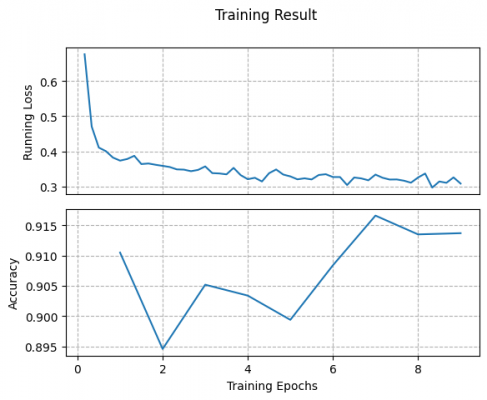

MNIST/CNV
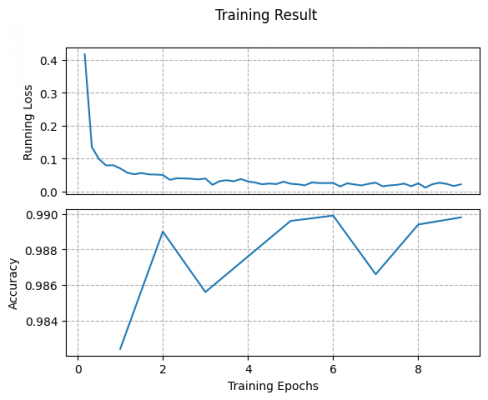

MNIST/CNV as Regression
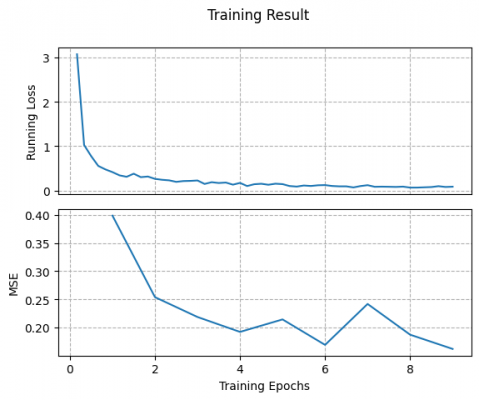
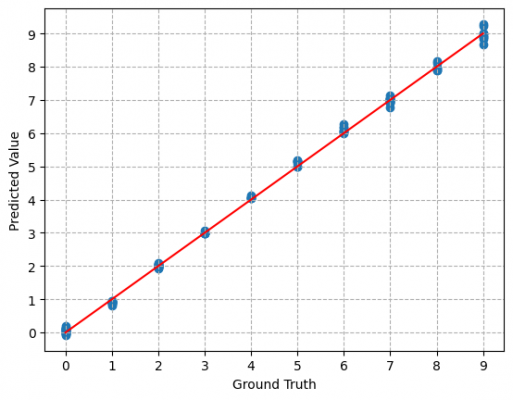
MNIST/ResNet with Transfer Learning
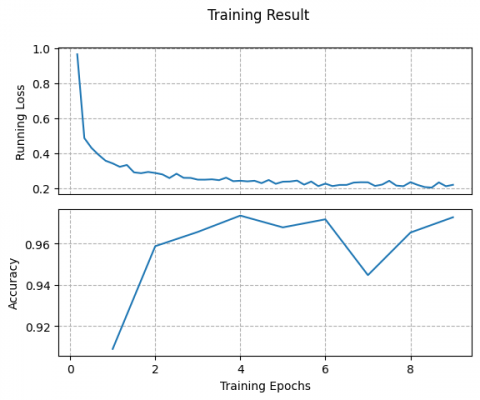

MNIST/ResNet as Regression
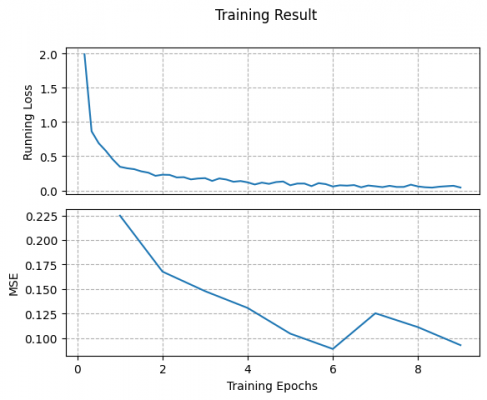
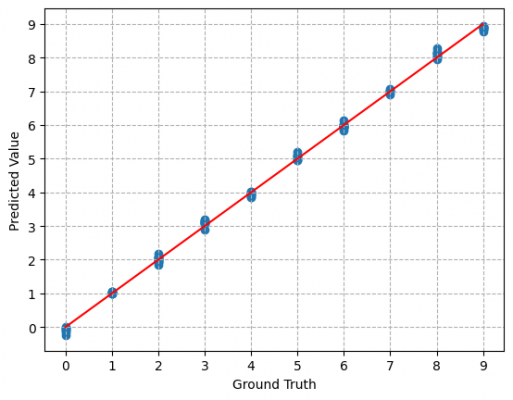
MNIST/ViT(Vision Transformer) with Transfer Learning
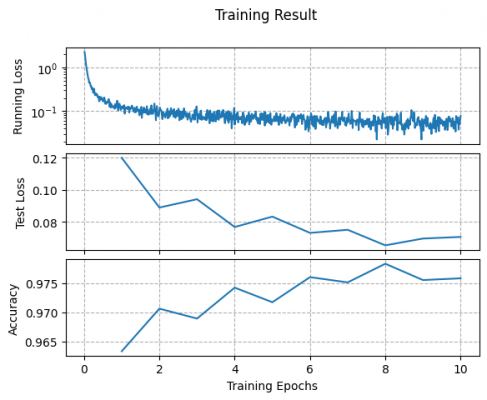

CIFAR10/CNV
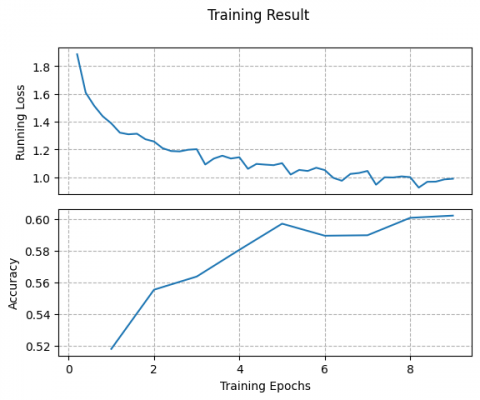
CIFAR10/ResNet with Transfer Learning
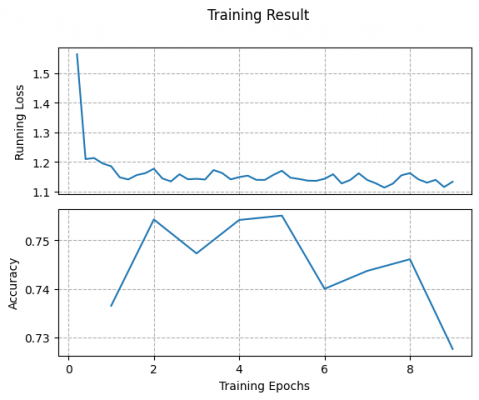
Custom Dataset/MLP
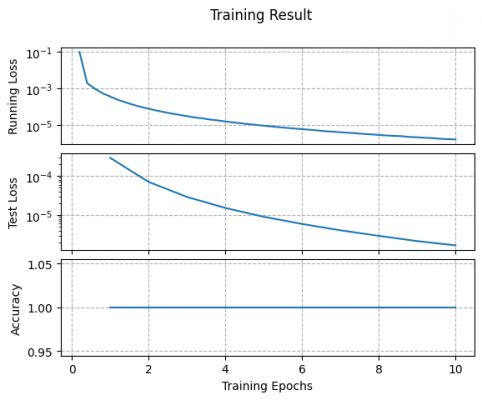

PyTorch+ONNX/SwinTransformer
https://pytorch.org/docs/stable/onnx.html

366 n02480855 gorilla, Gorilla gorilla 7.715928 741 n03998194 prayer rug, prayer mat 6.302113 367 n02481823 chimpanzee, chimp, Pan troglodytes 5.2681127 371 n02486261 patas, hussar monkey, Erythrocebus patas 4.407563 365 n02480495 orangutan, orang, orangutang, Pongo pygmaeus 3.6513
Usage
Save/Load
torch.save(model.state_dict(), 'model.pth')
model = NetworkClass(*args, **kwargs)
model.load_state_dict(torch.load('model.pth'))
Troubleshooting - No CUDA Device
## RuntimeError: Attempting to deserialize object on a CUDA device but torch.cuda.is_available() is False.
## If you are running on a CPU-only machine, please use torch.load with map_location=torch.device('cpu') to map your storages to the CPU.
model.load_state_dict(torch.load('model.pth', map_location=torch.device('cpu')))
Transforms
https://pytorch.org/vision/stable/generated/torchvision.transforms.Compose.html
https://pytorch.org/vision/stable/generated/torchvision.transforms.ToTensor.html
https://pystyle.info/pytorch-list-of-transforms/
https://blog.kikagaku.co.jp/pytorch-torchvision
transform = transforms.Compose([transforms.ToTensor()]) transform = transforms.Compose([transforms.ToTensor(), transforms.Normalize((0.5, 0.5, 0.5), (0.5, 0.5, 0.5))]) transform = transforms.Compose([transforms.CenterCrop(224), transforms.ToTensor(), transforms.Normalize((0.5, 0.5, 0.5), (0.5, 0.5, 0.5))])
The sequence of transforms is important: transforms.Normalize to [-1, 1] should be after transforms.ToTensor to [0, 1] from an original image array in the range [0, 255] as numpy.uint8
Information - Automatic Image Augmentation
https://sebastianraschka.com/blog/2023/data-augmentation-pytorch.html
transform = transforms.Compose([transforms.AutoAugment(), transforms.ToTensor()]) transform = transforms.Compose([transforms.RandAugment(), transforms.ToTensor()]) transform = transforms.Compose([transforms.AugMix(), transforms.ToTensor()]) transform = transforms.Compose([transforms.TrivialAugmentWide(), transforms.ToTensor()])
Network Design
See Deep Learning for details
Information - Softmax Output
https://pytorch.org/docs/stable/generated/torch.nn.CrossEntropyLoss.html
https://qiita.com/y629/items/1369ab6e56b93d39e043
https://qiita.com/ground0state/items/8933f9ef54d6cd005a69
https://qiita.com/takurooo/items/e356dfdeec768d8f7146
## [IMPORTANT] Softmax should not be used at the output layer if using CrossEntropyLoss !!!
def __init__(self) :
super(NET, self).__init__()
self.fc = nn.Linear(input, output)
def forward(self, x) :
x = self.fc(x)
return x
criterion = nn.CrossEntropyLoss()
## Above calculation is equivalent to the combination of LogSoftmax + NLLLoss so that confirming softmax probabilities is available
def __init__(self) :
super(NET, self).__init__()
self.fc = nn.Linear(input, output)
self.logsoftmax = nn.LogSoftmax(dim=1)
def forward(self, x) :
x = self.logsoftmax(self.fc(x))
return x
criterion = nn.NLLLoss()
Information - Examples of Node Calculations of Convolutional Network
## FINN CNV inspired by BinaryNet and VGG-16 for (3, 32, 32) Input Images self.conv1 = nn.Conv2d(3, 64, 3) ## 003x(032x032) -> 064x(030x030) self.conv2 = nn.Conv2d(64, 64, 3) ## 064x(030x030) -> 064x(028x028) self.pool1 = nn.MaxPool2d(2, 2) ## 064x(028x028) -> 064x(014x014) self.conv3 = nn.Conv2d(64, 128, 3) ## 064x(014x014) -> 128x(012x012) self.conv4 = nn.Conv2d(128, 128, 3) ## 128x(012x012) -> 128x(010x010) self.pool2 = nn.MaxPool2d(2, 2) ## 128x(010x010) -> 128x(005x005) self.conv5 = nn.Conv2d(128, 256, 3) ## 128x(005x005) -> 256x(003x003) self.conv6 = nn.Conv2d(256, 256, 3) ## 256x(003x003) -> 256x(001x001) self.fc1 = nn.Linear((256 * (1 * 1)), [next])
## Simple Convolutions for (3, 32, 32) Input Images self.conv1 = nn.Conv2d(3, 6, 5) ## 003x(032x032) -> 006x(028x028) self.pool1 = nn.MaxPool2d(2, 2) ## 006x(028x028) -> 006x(014x014) self.conv2 = nn.Conv2d(6, 16, 5) ## 006x(014x014) -> 016x(010x010) self.pool2 = nn.MaxPool2d(2, 2) ## 016x(010x010) -> 016x(005x005) self.fc1 = nn.Linear((16 * (5 * 5)), [next])
https://qiita.com/hiromasat/items/43e20c8da6d21f2578dc
Number of Parameters = ( (Input Channels x Kernel Size) + Bias ) x Output Channels
Custom Loss Function
class RMSELoss(nn.Module) :
def __init__(self) :
super(RMSELoss, self).__init__()
def forward(self, outputs, targets) :
loss = torch.sqrt(torch.mean(torch.abs(outputs - targets) ** 2.0))
return loss
criterion = RMSELoss()
Troubleshooting - Target Size Difference
https://qiita.com/kimisyo/items/579d380b991995976f79
https://stackoverflow.com/questions/61598771/pytorch-squeeze-and-unsqueeze
## UserWarning: Using a target size (torch.Size([16])) that is different to the input size (torch.Size([16, 1000])). ## This will likely lead to incorrect results due to broadcasting. Please ensure they have the same size. ## ... ## RuntimeError: The size of tensor a (1000) must match the size of tensor b (16) at non-singleton dimension 1
## Target sizes of outputs and labels tensors should be the same: loss = criterion(outputs, labels) loss = criterion(outputs.squeeze(-1), labels) loss = criterion(outputs.unsqueeze(-1), labels)
Convert Tensor/NDArray
https://tzmi.hatenablog.com/entry/2020/02/16/170928
## NumPy NDArray to PyTorch Tensor x = torch.from_numpy(x.astype(np.float32)).clone()
## PyTorch Tensor to NumPy NDArray
x = x.to('cpu').detach().numpy().copy()
Troubleshooting - Long-Type Expected in CrossEntropyLoss
## RuntimeError: Expected object of scalar type Long but got scalar type Float
loss = criterion(output, target.long()) loss = criterion(output, target.type(torch.long))
Training
inputs, labels = data[0].to(device), data[1].to(device) optimizer.zero_grad() outputs = net(inputs) loss = criterion(outputs, labels) loss.backward() optimizer.step()
Troubleshooting - Runtime Error
https://discuss.pytorch.org/t/runtimeerror-could-not-create-a-primitive/117519
## RuntimeError: could not create a primitive descriptor iterator
The host machine needs more system memory
Another workaround is preparing additional swap memory: see Swap for instructions
PyTorch Hub
https://pytorch.org/hub/
https://pytorch.org/vision/
https://pytorch.org/vision/stable/models.html
net = torch.hub.load('pytorch/vision', 'resnet18', weights='DEFAULT')
Troubleshooting - Import Error
https://github.com/pytorch/vision/issues/7397
https://github.com/pytorch/vision/issues/6431
## File ~/.cache/torch/hub/pytorch_vision_main/hubconf.py:74 ## 72 from torchvision.models.swin_transformer import swin_b, swin_s, swin_t, swin_v2_b, swin_v2_s, swin_v2_t ## 73 from torchvision.models.vgg import vgg11, vgg11_bn, vgg13, vgg13_bn, vgg16, vgg16_bn, vgg19, vgg19_bn ## ---> 74 from torchvision.models.video import ( ## 75 mc3_18, ## 76 mvit_v1_b, ## 77 mvit_v2_s, ## 78 r2plus1d_18, ## 79 r3d_18, ## 80 s3d, ## 81 swin3d_b, ## 82 swin3d_s, ## 83 swin3d_t, ## 84 ) ## 85 from torchvision.models.vision_transformer import vit_b_16, vit_b_32, vit_h_14, vit_l_16, vit_l_32 ## ## ImportError: cannot import name 'swin3d_b' from 'torchvision.models.video' (/opt/.../python3.8/site-packages/torchvision/models/video/__init__.py)
## Specify an old version number:
net = torch.hub.load('pytorch/vision:v0.13.0', 'resnet18', weights='DEFAULT')
ONNX Export
https://learn.microsoft.com/windows/ai/windows-ml/tutorials/pytorch-analysis-convert-model
https://pytorch.org/tutorials/advanced/super_resolution_with_onnxruntime.html
## Model Definition model = NetworkClass(*args, **kwargs)
## [IMPORTANT] Model as Inference Mode !!! model.eval()
## Preparing Dummy Input Tensor dummy_input = torch.randn(1, 1, 28, 28, requires_grad=True) #dummy_input = torch.randn(1, 3, 32, 32, requires_grad=True)
## ONNX Export torch.onnx.export(model, dummy_input, 'model.onnx', input_names=['input'], output_names=['output'], verbose=True)
Troubleshooting - Bad Node Spec
https://discuss.pytorch.org/t/onnx-custom-operator-runtime-error/
## Traceback (most recent call last): ## File "<stdin>", line 1, in <module> ## File "/opt/conda/lib/python3.8/site-packages/torch/onnx/__init__.py", line 225, in export ## return utils.export(model, args, f, export_params, verbose, training, ## File "/opt/conda/lib/python3.8/site-packages/torch/onnx/utils.py", line 85, in export ## _export(model, args, f, export_params, verbose, training, input_names, output_names, ## File "/opt/conda/lib/python3.8/site-packages/torch/onnx/utils.py", line 662, in _export ## _check_onnx_proto(proto) ## RuntimeError: No Op registered for GreaterOrEqual with domain_version of 9 ## ## ==> Context: Bad node spec: input: "43" input: "44" output: "45" name: "GreaterOrEqual_19" op_type: "GreaterOrEqual"
## Add operator_export_type to torch.onnx.export: torch.onnx.export(model, dummy_input, 'model.onnx', input_names=['input'], output_names=['output'], verbose=True, operator_export_type=torch.onnx.OperatorExportTypes.ONNX_ATEN_FALLBACK)
References
PyTorch
https://pytorch.org/
https://pytorch.org/tutorials/beginner/blitz/cifar10_tutorial.html
https://pytorch.org/tutorials/beginner/basics/data_tutorial.html
https://pytorch.org/hub/pytorch_vision_resnet/
PyTorch入門
https://ex-ture.com/blog/2021/01/01/pytorch-basic/
https://ex-ture.com/blog/2021/01/02/googlecolab-pytorch/
https://ex-ture.com/blog/2021/01/04/pytorch-nn/
https://ex-ture.com/blog/2021/01/08/freehand-accuracy/
https://ex-ture.com/blog/2021/01/11/pytorch-cnn/
https://ex-ture.com/blog/2021/01/11/cnn-cifar10/
https://ex-ture.com/blog/2021/01/12/pytorch-rnn/
https://qiita.com/mathlive/items/8e1f9a8467fff8dfd03c
https://qiita.com/takawamoto/items/42ff569be496621fc016
https://qiita.com/hcchiu1202/items/6d32d679fc97443901a1
https://qiita.com/hcchiu1202/items/7ac09c4c8a7dd4701c28
Acknowledgments
Daiphys is a professional services company in research and development of leading-edge technologies in science and engineering.
Get started accelerating your business through our deep expertise in R&D with AI, quantum computing, and space development; please get in touch with Daiphys today!
Daiphys Technologies LLC - https://www.daiphys.com/